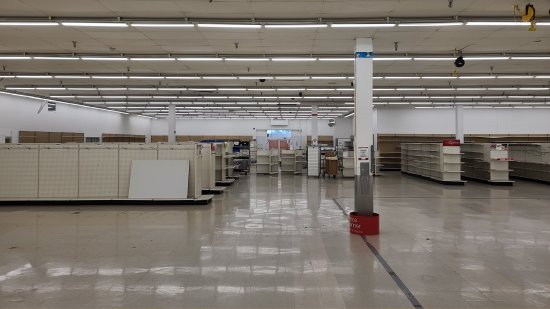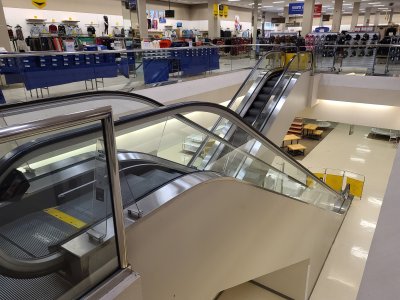Some sad looking retail…
6 minute read
August 9, 2020, 11:44 AM
On Saturday, Elyse, Aaron and Evan Stone, and I went out and visited the Kmart store in Aspen Hill, and the Sears store in White Oak. The last time that I had been to either of these stores was in 2017, well before the Sears bankruptcy. I had heard on social media about the way that the remaining non-closing Sears and Kmart stores were being merchandised, and I felt like it was time to see it for myself. What I saw was what I more or less expected based on what I saw online, but definitely not what someone might expect for a retail business that is still a going concern.
We first visited the Kmart on Connecticut Avenue, which is located less than a mile away from my old apartment on Hewitt Avenue. I knew this Kmart well enough, though I was never a regular there by any means. This is also the last Kmart in Maryland to remain a going concern, as the store in Edgewater is currently conducting a store-closing sale, and all of the other Kmart stores in Maryland are gone.
This is the state that the Aspen Hill store was in:

Endcap signage. Note the sign about a face mask’s being required in the store.
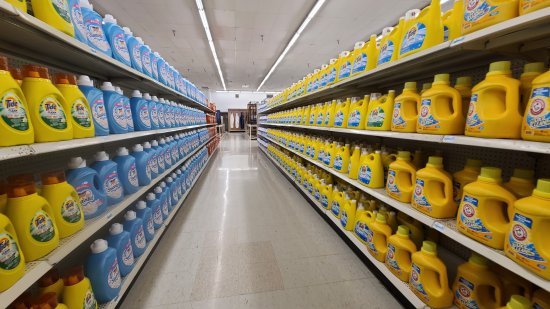
One of several aisles near the front of the store loaded with laundry detergent. Seriously, there was no shortage of laundry detergent in this store.

The easternmost (right-side) third of the store was closed off by using shelving to form a wall. I guess that if you’re going to be this light on merchandise to begin with, you might as well condense the store down a bit by blocking off sections of it. Somewhat ironic to block off a section of the store, though, considering that based on the appearance of the roof, this store was expanded to the west at some point during the 1990s.
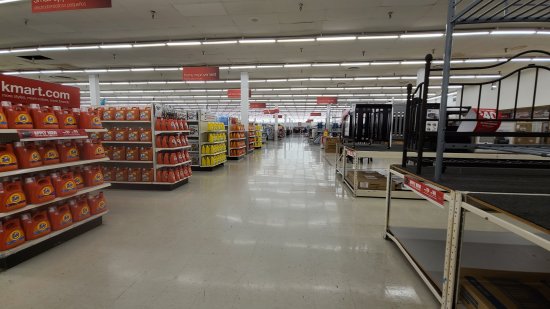
View facing approximately west, showing the back action alley. Note the many aisles of detergent.

Kid-sized shirt in the clothing section, reading “taters over haters”.

Face mask signage in the clothing section. The fitting rooms, visible in the background, were closed because of coronavirus.
There were some things that were noticeably absent from this store. One was the electronics department. There was no electronics department whatsoever. Even more noticeable was the lack of a grocery section. Following the wave of store remodelings to the “Big Kmart” model in the 1990s, most Kmart stores got grocery sections, and a grocery section existed here when I first moved to the area in 2007, though the “Big Kmart” era signage had been replaced by then. But now, no more food. The rest of the store was set up to make the shelves look full, though I don’t know who they were trying to fool with that, because it still looked quite sparse.
This store used to be so much more than this. It used to be full of merchandise, though I’ve never seen it crowded with shoppers. It actually reminded me a lot of a Kmart store in liquidation, but this store was a going concern, and there was even a sign on the door to that effect. It said, “We are staying open and remain committed to serving the community. Thank you, Aspen Hill, for your continued loyalty!” In any case, the presentation makes me think that Kmart isn’t too much longer for this world, and that despite what some employee printed on a sign on the front door about being committed to serving the community, they are really just biding their time until corporate decides to close them as well.
Then, upon leaving Kmart, we headed down to White Oak to check out the Sears. This is one of three Sears stores remaining open in Maryland, with the others in Frederick and Glen Burnie. The Sears had a noticeably better presentation than the Kmart, as its bi-level design made it easier to condense the store down without making it look quite as obvious as the Kmart. Here’s what it looked like:
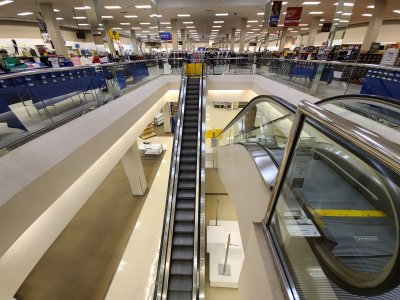
Escalators going down to the lower level, shut off and barricaded. Only the far end of the lower level (furthest from the camera) was accessible to customers via a stairway and an elevator for access to the portrait studio and the restrooms.

Signs describing their “mattress policy”, prohibiting customers from sitting on the beds, because coronavirus.
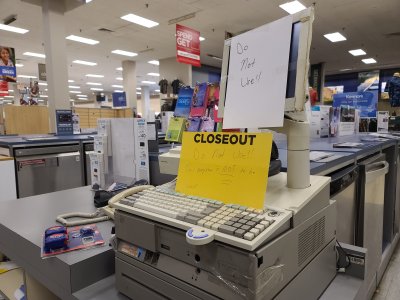
Cash register in the appliance department, which apparently is not to be used under any circumstances.
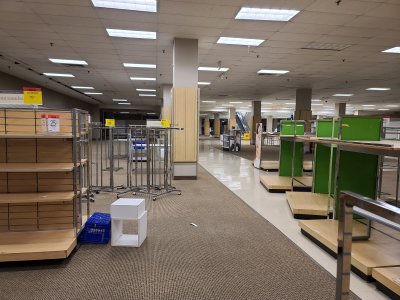
The closed-off section of the lower level of the store, being used to store spare fixtures.
This store has also definitely seen better days, though it looks a bit better than the Kmart store in Aspen Hill does. Despite the closed-off lower level, the Sears otherwise looked like a normal store. There wasn’t the need to make the space look full like there was at Kmart, because it looked like it had enough merchandise to fill it normally. It didn’t give me the same impression that the store was biding its time until corporate pulled the plug on it like I got with Kmart.
All in all, though, I feel like the end is near for both Kmart and Sears. People in the various retail groups love referring to parent company owner Eddie Lampert as “Fast Eddie”, talking about how he’s killing an American institution and blah blah blah, but I suspect that Lampert is a lot more savvy than these people give him credit for. Recall that Lampert got involved with Kmart following its bankruptcy in the early 2000s, and then acquired Sears a few years later and combined the two into a single company. Both companies have been shedding locations for a long time now, and I suspect that this is deliberate, and the pace is controlled. Lampert seems to be playing the long game. I suspect that he always knew that the retail side of Sears and Kmart was a bit of a loser, but that the real estate is where the real value lies. But if he closed everything at once, he would flood the market and get no return on his investment. Thus the slow bleed, maintaining the retail operation at the various locations until they’re ready to do something with it. By liquidating the retail operation in slow motion, he’s gradually releasing the real estate into the market, maintaining a decent price for it because they’re not flooding the market. It seems like we’re getting into the end of the bleed, though, as by the calculations by a retail group that I’m in on Facebook, there are 74 Sears stores and 41 Kmart stores remaining as going concerns as of this past May. I am not going to try to predict when Sears and Kmart will finally disappear, because every time I predict that it will be the company’s last Christmas, it makes it through it. But I imagine that the company doesn’t have too many Christmases left in it, though I’m pretty certain that it will make it through this one.
In any case, Kmart and Sears definitely seem like they’ve passed the point of no return, and that it’s only a matter of time before they are gone completely. I suspect that the company will not go out with a bang, like other companies that liquidated have done, having a massive final sale at all of their locations and closing. Rather, Kmart and Sears will continue the gradual liquidation until there is nothing left to close, and the retail business ceases to exist because there’s nothing left. The press will wax nostalgic about the closure of the final Kmart and Sears stores, respectively, and that will be it. It’s just too bad that our last memories of these once-great names will be of stores that are just kind of hanging on, having outlived their relevance a long time ago.
Categories: Companies, Elyse, Friends, Retail, Silver Spring











